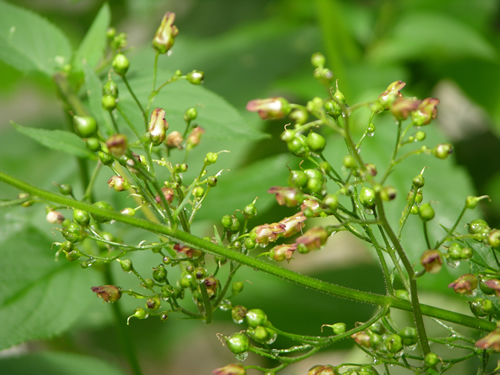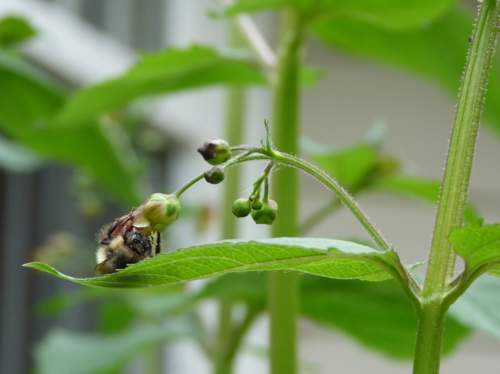Figwort |
m | ||||||
Posted to Subscribers on 3 August 2011 |
|||||||
|
|
In the saga of genetic modified crops vs organic and non-toxic food, score one for the environment! In a recent victory in Minnesota, the appeals court ruled that those who wish to grow food free of pesticides and franken foods can sue for damages! http://www.naturalnews.com/033216_GMO_contamination_lawsuits.html For the U.S., this is true victory because while some countries and a county here and there are banning these experimental crops, most U.S. courts have caved to pressure from the deep pockets that pad our political system. On a much more personal note, I just want to talk about bees . . . yes, again.
I believe I have mentioned that the bees who forage here are passionately in love with figwort, Scrophularia nodosa. This has tiny, tiny flowers but if you look at the size of a bee and compare it to the flower, it would be like saying that something that is18 inches tall is huge for a human. These little flowers are actually just the perfect size for our little pollinators and the figwort produces just gazillions of them, yes, gazillions, like the national debt. Sorry, couldn't resist. The flowers appear really early in the season and they just keep producing and producing until late into the year. I built a little, really little, bee house for my bee friends and I watch them from the window in my kitchen dining area. They are intense little creatures, very focused on what they are doing. If I go out with the camera, they totally ignore me. However, I went out with pruning shears and they buzzed me, kind of like a dog growling if you move his bone. I got the message. I put down the clippers and picked up the camera and peace was restored. This herb is the primary ingredient of Seneca Elixir, the formula bequested by Dr. Eli G. Jones to his fellow physicians because he attributed about 80% of his success in treating cancer to Compound Syrup Scrophularia. It is also useful for skin diseases, everything from psoriasis to gangrene. For this purpose, it can be used both internally and externally. I wanted to get on a first name basis with it so I grew the plant just to watch it. I have found that it is a good parasiticide as well as antitumoral.
Yesterday, someone asked about the Essiac seed packet. It's not available because slippery elm is so hard to source right now. I urged her to consider figwort instead. This plant is famous for supporting proper flow through the lymphatic system. According to the "books", this plant grows to about zone 7 and reaches a height of one meter (3 feet), but this is absolute nonsense. My plants are at least 10 feet tall, way, way taller than I am, maybe not twice as tall but they are tall. In this image, you see a bee on its back, very tired at the end of the day, but still dining on figwort. It's one of the most precious photos I ever took. Figwort is exceptionally easy to grow and I have not found it to be invasive. It is planted next to mint and seems very happy with the morning sun. I harvested a bit yesterday, but I waited for bee balm to come into bloom and for the bees to discover it before going back with the clippers. I also bought a new pair of clippers, supposedly nylon, not metal. They are very light and had great reviews. It just seemed that this would be preferable for plants that are highly reactive with metals. This is obsessing me because of the radiation. The alpha particulates being discussed are similar to the toxic metals we try to chelate and whenever I have a metallic taste in my mouth, one of the symptoms being reported in Japan, I wolf down a bit of cilantro or make a cilantro pesto or chutney until the taste goes away. So, if any of you have favorite cilantro recipes, perhaps you'd share them? Please! Now, on a related note, I added several books to the catalogue last night. The first is Jeffrey Smith's Seeds of Deception. This is cited in countless anti-GMO initiatives and gives chapter and verse accounts of fraudulent "research" and horrendous consequences of ingesting this nightmarish food. The next is Gardening at the Dragon's Gate by Wendy Johnson, a Zen gardener who presents the concept of tranquility most eloquently. The third is In Resonance with Nature by Hans Andeweg. It covers healing of ourselves and land through recognizing energies and their vibrations. I hope some of you will dive into these waters. http://www.seventhraypress.com/related_subjects/gardening_books.php Finally, though absolutely unrelated, I would like to draw your attention to yet another essay by Ellen Brown. For those who forget, which sometimes includes me, she is the lawyer who has countless brilliant and practical ideas for reforming our criminally corrupt banking system. She seems to have an endless supply of cogent and compelling ideas and is always clear and user-friendly when presenting them. http://www.opednews.com/articles/2/Forget-Compromise-The-Deb-by-Ellen-Brown-110731-231.html Throughout history, when corruption reaches the level we are currently witnessing, there have been powerful reactions. The first choice is reform, but when the people who created the problems are put in charge of the reforms, the reforms are usually meaningless. This however leads to greater reactions and ultimately something strong enough to overthrow the corruption. This is rarely peaceful, but I might take it up in the context of the series on the adrenals because we have choice and we can choose a Ron Paul type Revolution or a less sanguine one. Blessings, Ingrid The adrenal series is archived here:
Copyright by Ingrid Naiman 2011
|
||||||
Home || Contact Us |
|||||||
No content on any of the pages of this web site may be reproduced without written permission of Ingrid Naiman and Seventh Ray Press, publisher of this site. |
|||||||
|
|||||||


